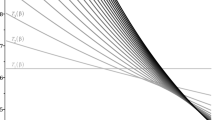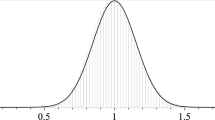Abstract
The work of Aarseth and Zare (1974) is extended to provide aglobal regularisation of the classical gravitational three-body problem: by transformation of the variables in a way that does not depend on the particular configuration, we obtain equations of motion which are regular with respect to collisions between any pair of particles. The only cases excepted are those in which collisions between more than one pair occur simultaneously and those in which at least one of the masses vanishes. However, by means of the same principles the restricted problem is regularised globally if collisions between the two primaries are excluded. Results of numerical tests are summarised, and the theory is generalised to provide global regularisations, first, for perturbed three-body motion and, second, for theN-body problem. A way of increasing the number of degrees of freedom of a dynamical system is central to the method, and is the subject of an Appendix.
Similar content being viewed by others
References
Aarseth, S. J.: 1971a,Astrophys. Space Sci. 13, 324.
Aarseth, S. J.: 1971b,Astrophys. Space Sci. 14, 118.
Aarseth, S. J. and Zare, K.: 1974, this issue, p. 185.
Allen, C. and Poveda, A.: 1971,Astrophys. Space Sci. 13, 350.
Baumgarte, J.: 1972,Celes. Mech. 5, 490.
Bettis, D. G. and Szebehely, V.: 1971,Astrophys. Space Sci. 14, 133.
Broucke, R. and Lass, H.: 1973,Celes. Mech. 8, 5.
Fehlberg, E.: 1968, ‘Classical Fifth-, Sixth-, Seventh-, and Eighth-order Runge-Kutta Formulas with Stepsize Control’, NASA Technical Report 287.
Goldstein, H.: 1950,Classical Mechanics, Addison-Wesley.
Heggie, D. C.: 1972, ‘Binary Evolution in Stellar Dynamics’, Ph.D. Thesis, University of Cambridge, unpublished.
Heggie, D. C.: 1974, in B. D. Tapley and V. Szebehely (eds.),Recent Advances in Dynamical Astronomy, D. Reidel Publ. Co., p. 34.
Lemaître, G.: 1952,Bull. Acad. Roy. Belg. 38, 582 and 1218.
Lemaître, G.: 1955,Vistas in Astronomy 1.
Peters, C. F.: 1968,Bull. Astron. 3, 167.
Siegel, C. L. and Moser, J. K.: 1971,Lectures on Celestial Mechanics, Springer.
Stiefel, E. L. and Scheifele, G.: 1971,Linear and Regular Celestial Mechanics, Springer.
Szebehely, V.: 1967,Theory of Orbits, A.P.
Szebehely, V.: 1968,Bull. Astron. 3, 33.
Szebehely, V. and Peters, C. F.: 1967,Astron. J. 72, 876.
Waldvogel, J.: 1967,Bull. Astron. 3, 295.
Waldvogel, J.: 1972,Celes. Mech. 6, 221.
Author information
Authors and Affiliations
Rights and permissions
About this article
Cite this article
Heggie, D.C. A global regularisation of the gravitationalN-body problem. Celestial Mechanics 10, 217–241 (1974). https://doi.org/10.1007/BF01227621
Received:
Issue Date:
DOI: https://doi.org/10.1007/BF01227621




